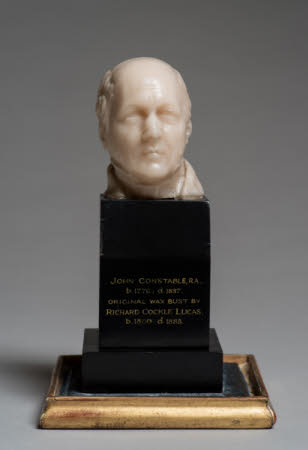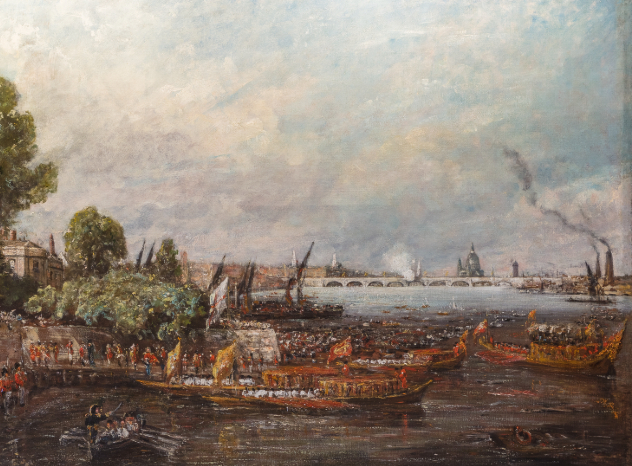John Constable RA (1776–1837)
Richard Cockle Lucas (Salisbury 1800 – Chilworth 1883)
Category
Art / Sculpture
Date
1831 (signed and dated)
Materials
Wax, wood, glass
Measurements
170 mm (Height)
Place of origin
Great Britain
Order this imageCollection
Anglesey Abbey, Cambridgeshire
NT 516590
Summary
Wax, John Constable RA (East Bergholt 1776 – London 1837) by Richard Cockle Lucas (Salisbury 1800 – Chilworth 1883), inscribed Constable on back of collar and signed 1831/R C Lucas on left collar. A small wax portrait of the painter John Constable by Richard Cockle Lucas, mounted on a painted and gilt wood base and encased in glass.
Full description
Born at Harnham near Salisbury in 1800, Richard Cockle Lucas began his career at the age of twelve as an apprentice cutler to his uncle and became a skilled carver of knife handles. He entered the Royal Academy Schools in 1828 and trained under Sir Richard Westmacott RA (1775-1856), Professor of Sculpture (1827-56). Lucas lived in London (1828-49), at Otterbourne near Winchester and finally Chilworth near Southampton (1854), and until 1859 exhibited regularly at the RA, the Society of British Artists and the British Institution. He submitted ivory carvings and imitation bronzes to the Great Exhibition of 1851. Lucas completed important commissions for funerary monuments and public statuary but is more widely known for his small-scale sculpture in ivory and wax, chiefly portraits and mythological subjects. Several works at Stourhead are associated with a notable commission for Sir Richard Colt Hoare, a memorial sculpture at Salisbury Cathedral in which Hoare is shown as the prototypical antiquarian, seated and writing in a comfy chair, surrounded by his books and papers (NT 732902, 732903, 732904, 732918, 732941). In addition to sculpture Lucas pursued painting, illustration and photography and was also a prolific writer, his subjects ranging from art and architectural history to fairy tales. In 1845 he made wood and wax models of the Parthenon, the first depicting how he thought the newly erected building might have looked, the second after its damage in the 1687 Siege of the Acropolis (see British Museum, London, inv. no. 1877,0811.336-353 for the related publication). The models were bought by the British Museum and installed in the Elgin Room alongside the Parthenon sculpture. A series of self-portrait photographs showing the artist in a variety of theatrical guises and expressions is held at the National Portrait Gallery, London (NPG Ax23400–441). In 1865, with the support of his friend and patron Lord Palmerston, Lucas secured a civil list pension of £150 p.a. in return for donating works to the South Kensington Museum (V&A; see, for example 177-1865, 191-1865, 209-1865). He died at Tower of the Winds, Chilworth – the second house the artist had designed and built for himself – in 1883. In the same year that Lucas carved this miniature bust of John Constable, the painter exhibited at the Royal Academy (then at Somerset House) his most ambitious ‘six-footer’ to date, Salisbury Cathedral from the Meadows (Tate Britain, London, T13896). Salisbury was a place of great meaning to Constable, the painting itself considered to have expressed ‘the fullest impression of the compass of his art’ (Leslie 1896, p. 294). A bravura and highly charged image, it was painted in the years following his wife Maria’s death and was his third and final exhibited depiction of that landscape. Salisbury Cathedral is shown against a thunderous sky from a vantage point on the River Nadder, with Harnham Water Meadows at right. The size, facture and drama of the picture bewildered and indeed irritated many contemporary critics, exhibited, as it was, on Constable’s instruction, between two equally large landscapes by his rival JMW Turner. While still enrolled in the Royal Academy Schools, Lucas’s own contribution to the 1831 exhibition included, among eight entries, busts of two men directly and indirectly associated with Salisbury Cathedral. A bust of Thomas Burgess (1756–1837), then the Bishop of Salisbury (1825–37) was shown in the Model Academy (no. 1137), and in the Library (no. 1116), a bust of the Rev. Dr Philip Fisher (1750–1842), Master of Charterhouse School and brother to John Fisher (1748–1825) who preceded Burgess as Bishop. These were most likely wax portraits carved in relief. Not exhibited but in the collection of Salisbury Museum is an undated wax relief portrait by Lucas of the Bishop John Fisher. Lucas would go on to exhibit a model, most probably in wax, for a ‘statue’ of Bishop Burgess in 1835 (RA no. 1119; untraced). Several versions of wax portraits of Dr Edward Denison (who succeeded Burgess as Bishop of Salisbury) are known, the earliest, 1835, is recorded at Wilton House (Pyke 1973, p. 26). The Fishers were, through bonds of fraternal society and friendship, closely known to Constable and it was owed to Bishop John Fisher that the painter made his first visit to the city in 1811. A founder member of the British Institution and chaplain to the Royal Academy (1806), the Bishop was an early encourager and patron of Constable, his notable commission being Salisbury Cathedral from the Bishop's Grounds in 1820 (exh. RA. 1823) (V&A, inv.no. FA.33[O]). It was during this 1811 stay that Constable met John (later Archdeacon) Fisher (1788-1832), the bishop’s nephew and son of the Rev. Dr Philip Fisher, who settled in the Cathedral Close following his ordination in 1812. The two men became close friends and confidants, Constable describing their bond as ‘at once the pride – the honour – and the grand stimulus of my life’ (Beckett 1968, p. 132). He returned to Salisbury on several occasions and often for extended periods of time in 1816, 1820, 1821, 1823 and 1829, the last of these visits made on the encouragement of John Fisher whose letters appear to have motivated Constable to produce the painting finally exhibited in 1831. Alice Rylance-Watson 2022
Provenance
Bequeathed to the National Trust by Huttleston Rogers Broughton, 1st Lord Fairhaven (1896-1966) with the house and the rest of the contents.
Marks and inscriptions
Left collar: 1831/RC Lucas Back of collar: Constable Front of base: JOHN CONSTABLE, R.A./b. 1776: d. 1837/ ORIGINAL WAX BUST BY/ RICHARD COCKLE LUCAS/ b. 1800 d. 1883
Makers and roles
Richard Cockle Lucas (Salisbury 1800 – Chilworth 1883), sculptor
References
Leslie 1896: Charles Robert Leslie, Life and Letters of John Constable, R.A., […] Together with some notes on his work, etc. by Robert Charles Leslie, London 1896 Pyke 1973-86: E J Pyke, A Biographical Dictionary of Wax Modellers, Oxford and London 1973-1986 Beckett, 1962-1968: R.B.Beckett, (ed)., John Constable’s Correpondence, Ipswich, 1962-1968 Willis Fleming 2016: Harry Willis Fleming, Artist, tower, books: the memory theatre of Richard Cockle Lucas, PhD thesis, Middlesex University, embargoed until publication http://hwf.co.uk/projects/richard-cockle-lucas.html







